

Annie Hayes
Read more about Annie Hayes
- December 9, 2004
Case Study: E-recruitment gets Nike on track
- By Annie Hayes

The issue Nike currently receives around 800 CVs each month. It has on average 100 to 120 open positions at any one time at Nike’s EMEA Headquarters (HQ) in Hilversum, the Netherlands. These volumes used to place considerable pressure on the resourcing function to reduce the administration and lead-time in the recruiting process. Handling the inflow of applications became challenging as the regional HQ grew dramatically in size. This resulted in high numbers of CVs circulating in the business whilst the company had little capability of tracking their progress or handling enquiries from job applicants. “We have a firm policy that each applicant is a potential employee and customer and so we must respond appropriately, in an individual letter where possible,” commented Rolien Hoogers, EMEA staffing manager at Nike. “With only four people on the team, we were finding it increasingly hard to do that, and we were losing track of where CVs were in the company. We became concerned about how well we were protecting applicants’ personal information, and there were mistakes, such as us calling someone in for an interview who was already due to come in later that day.” The action These problems led Nike to review their HR processes. The assessment demonstrated that the company had to standardise its HR processes in an attempt to reduce duplication of effort. Reducing the cost per hire and improving the overall quality of talent hired into the business were key goals. Nike felt that achieving these objectives and improving effectiveness would help to boost the company image. Faster response times to applicants together with consistency in handling the administration associated with each appointment would lead to improved internal effectiveness and efficiency. The solution Jobpartners provided Nike with an e-recruitment solution, ActiveRecruiter, which has been designed to help companies manage the entire recruitment process more effectively and quickly resulting in a better relationship between the company and its candidates. The solution was chosen by Nike as it offered flexibility and simplicity, was cost effective and could be easily integrated with the existing programmes from PeopleSoft. A number of avenues are now open to candidates who wish to apply for jobs at Nike. External applicants can apply for specific roles or for more general speculative job opportunities directly via the Nike website. Electronic links have also been established with external web-based recruitment organisations including Monsterboard. Conventional resourcing processes including newspaper advertising and head-hunting , particularly for more senior positions supplement these e-methods. Nike employees can also directly apply for jobs posted on the intranet. The majority of applicants apply to Nike via the web site (www.nikebiz.com) and can attach their resume after filling in their profile enabling line managers to review applications online. Paper copy CVs are no longer required. ActiveRecruiter makes the first match between the job requirements and the competencies and experience of the candidate. The system then retains a pool of applicants on file, which ensures Nike has a readily available supply of CVs for open positions. The number of CVs currently held on the database is in the region of 8500. Each registered applicant is automatically asked to update their CV every six months in order to remain active on the system. The system is then able to search an expanding database of future interest when open positions arise. This helps to reduce the costs of recruitment. ActiveRecruiter also provides the ability to search for specific competencies when a short-listing for open positions is being run. This ensures a better quality of candidate. The result Hoogers comments: “Savings of around 54% in recruitment costs have been identified since the system was first introduced in July 2002, and there has been far less reliance on external recruitment and search agencies due to the ‘future interest’ database.” From June 2003 to May 2004, a total of 556 positions were filled with 235 internal Nike candidates, 144 from the Nike database, 60 through the internal referral bonus programme, and 35 via headhunting organisations. The remainder came from job adverts and recruitment consultancy, Adecco. The average time to fill vacancies has fallen from 62 days to 42 days. The cost per hire has also been reduced. Nike believes that ActiveRecruiter has given a return on investment in just six months. Lessons learnt The three key learning points identified by Nike during the process of change management include:
- 1.The importance of involving recruiters in the development and implementation process from an early stage.
- 2. The benefit of ensuring that recruiters have a place in the project to help get buy-in
- 3.The role of communication. Internal customers and users of the system have to see benefits, not just to the business as a whole, but also in terms of helping them to achieve their recruitment targets by attracting quality people with the necessary skills and attributes.
Future Trends Nike feels that even greater potential exists in improving the quality of the overall resourcing process as ActiveRecruiter is developed further in the EMEA region. The vision for ActiveRecruiter at Nike is for it to become a ‘one-stop-shop’ for quality recruiting. This will help ensure that increased time can be put into improving the capability of line management in interviewing techniques, and that the resourcing group can be freed up to play a more consulting and advisory role. Nike is planning to continue to measure and improve the effectiveness of its resourcing processes, which can only enhance its employer brand in the market place.
One Response
What kind of E recruitment What kind of E recruitment techniques followed by NiKE

Is your workplace culture one of blame?

Is your business clear or opaque when it comes to pay transparency?

Barclays discrimination claims: From lip service to lawsuits

New legal rights for carers: What HR professionals need to know
Most read this week.

- Culture , Lead
- 1st May 2024
Sainsbury’s employee dismissed for ‘stealing’ a shopping bag
- Kate Palmer
- 8th April 2024
- Sabina Mehmood

- 22nd March 2024
Why we need to rethink the meaning of talent
- Jackie Clifford

- 23rd April 2024
Identifying the risk factors for suicide within our organisations
- Mike McCarthy
Matt Somers - Coaching Culture Series
How to build a coaching culture
The fundamentals to crafting a coaching culture
Part one: Coaching for success
Building a coaching culture
Part two: What’s the story?
Why stories are a powerful tool for creating a coaching culture
Part three: Coaching as a ritual
Why coaching needs to be embedded as a cultural ritual
- About HRZone
- Privacy policy
- Sub-Processors List

Get the latest from HRZone
Subscribe to expert insights on how to create a better workplace for both your business and its people.
Company size 1-9 10-49 50 to 99 100 - 499 500 - 999 1,000 - 4,999 5,000 - 9,999 10,000 - 49,999 50,000 - 99,999 100,000 +
Role responsibility CIO CEO Chairman HR Director Head of HR HR Manager HR Officer/Assistant Manager But Not Dept Head Board Level Dir But Not HR HR Consultant Supplier to HR Training Dir/Head Training Manager Training Consultant Training Officer/Exec/Assistant Trainer/Coach/Mentor/Tutor Sales and Marketing/Bus Dev Academic/Lecturer Student
- SUGGESTED TOPICS
- The Magazine
- Newsletters
- Managing Yourself
- Managing Teams
- Work-life Balance
- The Big Idea
- Data & Visuals
- Reading Lists
- Case Selections
- HBR Learning
- Topic Feeds
- Account Settings
- Email Preferences
Reengineering the Recruitment Process

The skills needed in many roles are continually changing—and sources of talent are too.
The Covid-19 pandemic has upended many traditional business practices. When it comes to recruiting, the crisis has not so much disrupted as accelerated shifts in the talent landscape that were already under way, leaving many companies poorly served by their current hiring practices. In a period of steep unemployment, it might seem that companies looking to add workers would be in the driver’s seat. But job openings have also been rising in recent months, meaning that competition for top talent remains keen—and in uncertain times, bringing on the right people is more important than ever.
Partner Center
Your browser is ancient! Upgrade to a different browser or install Google Chrome Frame to experience this site.

Report summary: e-Recruitment: Is it Delivering?
E-recruiting, embracing the term web-based recruiting, can be described as any recruiting processes that a business organisation conducts via web-based tools, such as a firm’s public internet site or its corporate intranet. We use the terms online recruitment, internet recruitment, and e-recruitment interchangeably.
This e-recruitment study set out to answer the following questions, using evidence-based research:
- What are the overall trends in e-recruitment use and practice? Which parts of systems are web-enabled and what are the related benefits and challenges?
- What is happening in practice? What are the e-recruitment methods that are being used, and what are the real experiences from organisations attempting implementation?
- Does it work? How do organisations evaluate the success of their e-recruitment initiative?
There were four main phases to the project: a literature review, a survey, an IES Research Network event on e-recruitment, and a series of case studies. The survey provided the overview of use, while the case studies illustrated more in-depth analysis of some of the issues organisations are facing.
Trends in e-recruitment
There is growing evidence that organisations are using internet technology and the World Wide Web as a platform for recruiting and testing candidates. The IES survey of 50 organisations using e-recruitment reported that the primary drivers behind the decisions to pursue e-recruitment were to:
- improve corporate image and profile
- reduce recruitment costs
- reduce administrative burden
- employ better tools for the recruitment team.
Fifty-five per cent of respondents expected their organisation to reduce its use of other recruitment methods in the future. The key limiting factors to e-recruitment most frequently reported were:
- the cultural approach of the organisation towards recruitment
- the lack of knowledge of e-recruitment within the HR community
- internet usage by target candidates
- commitment of senior management.
Issues raised as causing concern with e-recruitment included the quantity and quality of candidates applying using web-based tools (eg organisations being inundated with CVs attached by email, many of whom were not suitable for the post), the relevance of shortlisting criteria (eg the validity and legality of searching by keywords), confidentiality and data protection, and ensuring diversity of applicants.
The trends in e-recruitment use suggest a changing landscape whereby in future the candidate is connected to the central system and there is involvement of the line manager in the process (see figure). In addition to the reported benefits such as cost efficiencies, the role of HR in this model is viewed as more of a facilitative role, in theory allowing time for recruiters to become involved in the strategic issues within resourcing.
Figure: The e-recruitment landscape
Source: IES
E-recruitment methods
Advertising job openings, tracking the source of applications, and online enquiry forms, were the most frequently used methods for attracting candidates. In many cases, web-based technology in selection and assessment is only being used by the most selection-sophisticated organisations that can afford the high start-up and maintenance costs. The IES survey reported that, out of the 50 organisations surveyed:
- a large proportion were using online application forms (67 per cent)
- only four per cent were using psychometric tests online.
There was wide variety in the extent to which online applications were structured, and also in how they were screened, eg electronically by keywords or manually. There exists a great deal of variation and less maturity in this part of the e-recruitment process in terms of application and use, than in the application of internet technology at the attraction stage of the process.
In terms of applicant tracking and workflow systems, of the 50 organisations surveyed, 78 per cent received CVs and application forms online, 49 per cent used email response letters, with 39 per cent using progress-tracking systems. Only nine per cent provided status reports to hiring managers.
Evaluating impact
The experiences of IES members suggest that the emergence of fundamentally new e-enabled recruiting processes not only increases the opportunities, but also the risks associated with the resourcing process. Hence, evaluation of those risks and benefits becomes more important. It is claimed that current measures of impact in this area focus on efficiency (input and output measures), as opposed to measures of effectiveness and quality of output. The evidence from the IES survey, which asked organisations to indicate which evaluation measures they used, suggests that the former is true. Number of successful applications, cost per hire and internet/intranet site traffic analysis, were the most frequently used measures in our sample; all input-output measures. Measures of quality were less evident.
Working with a small number of the case study organisations, a framework was developed and used as a mechanism for exploring the availability, and validity, of the data each organisation held on their staffing processes. The intention was to determine the usefulness of a supply-chain approach to measurement in making optimal investment decisions in e-recruitment systems, and in measuring the value of e-recruitment. The categories of measurement we explored with the participating companies were:
- cost of recruitment and selection activities
- time taken to fill
- volume/yield
- diversity and legal compliance
- candidate and employer satisfaction
- quality/value of the recruit.
IES case study members shared our conclusion that better information about the end-to-end process should lead to better decisions about any investment in e-recruitment. An evaluation approach linked to the staffing process, as ‘value chain’ we argue, is the way forward if organisations are going to truly understand the value of e-recruitment.
Implementation challenges
The findings from the survey indicated that key implementation challenges were the cultural approach of the organisation towards e-recruitment, and the lack of knowledge within the HR community. This has implications for training within HR to develop the capability to deliver e-recruitment, and also elsewhere within the organisation (eg at line manager level). Further implications of e-recruitment are that it may allow a more strategic role for HR. A compelling argument why online recruitment should be integrated sooner rather than later, is that it will serve to move the recruiter up the value chain, allowing them to be far more strategic. Finally, cultural and behavioural change was reported as the significant challenge in ensuring that e-recruitment delivers.
Assessing your organisation’s e-recruitment strategy
The experiences of Research Network members underline the complexity of considerations and possibilities of e-recruitment. The report also offers a series of self-assessment questions, which, if answered specific to your organisation and its HR function, provide the basis for an e-recruitment agenda.
Conclusions
What are the key messages from our research? In examining the findings, the key message for recruiters is to acknowledge that the adoption of e-recruitment is about more than just technology. It is about the recruitment system being able to attract the right candidate, the selection process being based on sound and credible criteria, and the tracking process being able to integrate with existing systems. Perhaps most significantly, e-recruitment is about cultural and behavioural change, both within HR and at line management level. From our evidence, we suggest that for e-recruitment to deliver, it is about developing the capability of HR to facilitate the system and to view the staffing process as an end-to-end process, similar to that of a supply-chain.
Related publications
Sign up to our newsletter.
Register for tailored emails with our latest research, news, blogs and events on public employment policy or human resources topics.
By continuing to use the site, you agree to the use of cookies. more information Accept
The cookie settings on this website are set to "allow cookies" to give you the best browsing experience possible. If you continue to use this website without changing your cookie settings or you click "Accept" below then you are consenting to this.
Conceptualizations of E-recruitment: A Literature Review and Analysis
- Conference paper
- First Online: 01 April 2020
- Cite this conference paper

- Mike Abia 14 &
- Irwin Brown 15
Part of the book series: Lecture Notes in Computer Science ((LNISA,volume 12067))
Included in the following conference series:
- Conference on e-Business, e-Services and e-Society
19k Accesses
3 Citations
There is diversity in understanding of electronic recruitment (e-recruitment) which results in confusion on the meaning and use of the term. The purpose of this paper is to bring conceptual clarity by investigating the alternative conceptualizations of e-recruitment in academic literature. Using Grounded Theory Methodology (GTM) techniques we analyzed literature to reveal five alternative conceptualizations; these being: (1) E-recruitment as a Technology Tool, (2) E-recruitment as a System, (3) E-recruitment as a Process, (4) E-recruitment as a Service, and (5) E-recruitment as a Proxy. The conceptualizations map to the scope of the definition and utilization of e-recruitment. Identifying conceptualizations of e-recruitment sets a platform for further research. Further research may include determining the relationships between the conceptualizations and determining conceptualizations in different settings among many other possible research focus topics.
You have full access to this open access chapter, Download conference paper PDF
Similar content being viewed by others

E-Recruitment and the Impact of Digital Age on Recruitment: A Critical Literature Review

e-Health intervention development: a synopsis and comment on “What Design Features are Used in Effective e-Health Interventions? A Review Using Techniques From Critical Interpretive Synthesis”

A Brief Glance About Recruitment and Selection in the Digital Age
- E-recruitment
- Conceptualization
- Literature review
- Grounded Theory Methodology
1 Introduction
E-recruitment has many labels that include; internet recruitment, online recruitment, web-recruitment and many others. Unlike traditional recruitment, e-recruitment makes use of information technology to handle the recruitment processes. Breaugh et al. [ 1 ] defined a recruitment model that presents the recruitment process at a macro level with the following activities: Setting recruitment objectives, developing a strategy, performing the recruitment activity and obtaining and evaluating recruitment results. Recruiters compete with each other for candidates (jobseekers suitable for available jobs), while jobseekers compete for jobs; which drives both groups to adopt information technologies at accelerated rates in order to take the strain out of some of the recruitment activities [ 2 , 3 , 4 , 5 , 6 , 7 ]. “ For most job seekers, the Internet is where the action is ” [ 3 , p. 140]. Thus, to get candidates, recruiters need to move swiftly to locate and hire, which may require use of a multitude of information technologies in the process [ 8 , p. 130].
There is evidence in research papers that academic disciplines and stakeholders have varied definitions of e-recruitment. The variety of definitions of e-recruitment is expected because it is part of e-HRM (electronic Human Resource Management) that has in itself different definitions depending on the context [ 6 , p. 26], [ 9 , p. 98]. Studies based on these definitions tend to reveal overlapping and contradictory results due to the overlaps or differences in definitions [ 9 , p. 100]. The differences in definitions, aside from being problematic, is evidence of the variety in conceptualization of e-recruitment. Thus to find a standard definition of e-recruitment, conceptualizations of e-recruitment need to be known. To our knowledge, no research paper in e-recruitment has focused on conceptualization of e-recruitment, however there are studies in other areas of information systems (IS) that have focused on conceptualization [ 10 , 11 , 12 , 13 , 14 , 15 , 16 , 17 , 18 , 19 ]. Most view conceptualization as the formulation of a view about the nature of a phenomenon. The research questions to be answered are:
What conceptualizations of e - recruitment exist in literature?
How can the conceptualizations be described and explained?
2 Methodology for Reviewing Literature
Because of the large number of research papers on e-recruitment we aimed at selecting papers for review that would embrace the full variety of conceptualizations of e-recruitment. Also, we wanted a flexible review methodology that would allow for selection and analysis of papers simultaneously, as the conceptualizations emerged, rather than a sequential review methodology that required all research papers to be selected beforehand. Such flexibility is provided for by applying grounded theory methodology (GTM) as a suitable review methodology [ 20 ]. GTM techniques used in this study included open coding to identify concepts, constant comparative analysis to refine and differentiate conceptualizations, and theoretical sampling to identify further relevant literature [ 21 , 22 ].
Figure 1 is a flowchart depicting how the literature was processed from search until conceptualizations of e-recruitment were identified, saturated and completed.
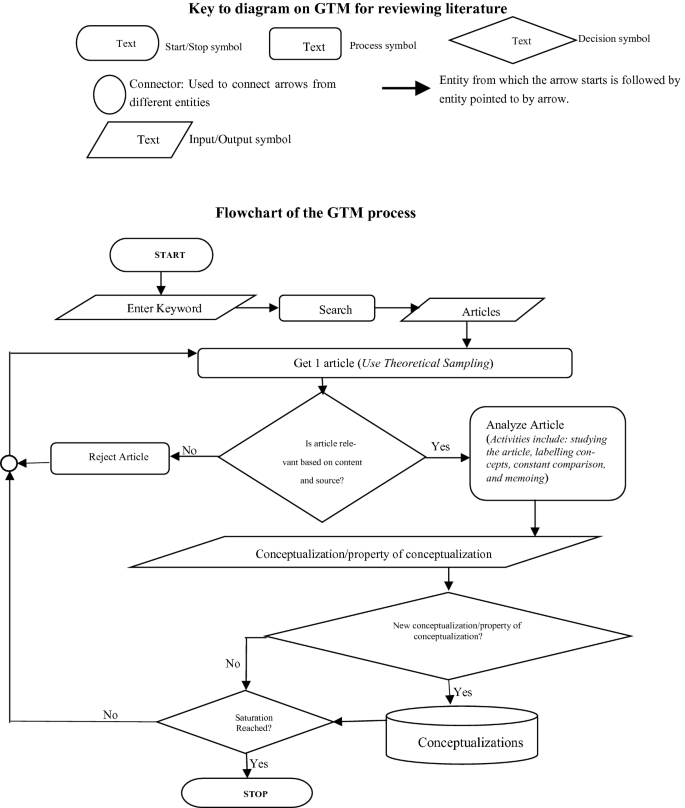
GTM for reviewing literature
2.1 Searching for Articles
We used the web search engine Google Scholar to search electronically for the articles. We fed keywords synonymic with the word e-recruitment into the searching tool. These are: e-recruiting, e-HRM, e-Human Resource Management, electronic HRM, electronic Human Resource Management, e-recruiting, e-recruitment, internet recruiting, internet recruitment, online recruiting, online recruitment, recruiting online, recruiting on the internet, recruiting on the web, recruitment online, web-based recruiting, web-based recruitment, web recruiting, web recruitment [ 20 ].
After an initial search on Google Scholar and filtering of articles for relevancy based on paper titles and abstracts we had 445 journal articles and conference papers published in the period 1998 to 2019 in approximately 145 sources. The search process provided a set of many articles, but it did not qualify all of them as useful for the review. The selection process had to take place to sample useful and relevant articles for the review.
2.2 Theoretical Sampling of Articles
Ideally all papers on e-recruitment needed to be included in the review. Alternatively, papers included in the analysis had to be a representative sample of all papers in e-recruitment that were relevant for the developing conceptualizations. However with the vast amount of research in e-recruitment and the huge number of articles from our search and filtering it would be difficult or time consuming to include all relevant e-recruitment research articles for the review. The alternative of having a representative sample was viable and using GTM’s theoretical sampling [ 21 ] was feasible for the objectives of this research to be met.
An initial article to be analyzed was picked from the population of 445 articles. Picking of subsequent articles for inclusion in the sample was informed by the emerging conceptualizations. Theoretical sampling was performed until all the conceptualizations got saturated and completed. Glaser [ 22 ] defines saturation as a state where new data does not bring new properties to the concepts. In an effort to attain completeness a check was done to make sure all conceptualizations were included. Theoretical sampling ended when saturation and completeness was achieved. This is the point at which the number of research articles involved in identifying conceptualizations in e-recruitment were counted. In the end 26 research articles were relevant for identifying and explaining conceptualizations of e-recruitment.
2.3 Analyzing Articles
Analysis of the articles that let conceptualizations of e-recruitment emerge (see Fig. 1 ) required that constant comparison be applied by comparing codes to codes and concepts to concepts to find and note their relationships and further develop the labelled conceptualizations [ 21 , 22 ]. The emerging conceptualizations served as a framework for further selection of articles and using systematic deduction from the emerging conceptualization possibilities and probabilities were determined to guide the next cycle of article selection. Memos were created to note the emergent ideas. Memoed ideas also served to direct which article to sample next.
Every sampled article was investigated for its perspective on the essence of e-recruitment or the most essential or most vital part that embodied the conceptualization of e-recruitment. Indicators in the article brought forth the conceptualizations. The moment of departure from the analysis to getting another article for analysis came only after the article was fully analyzed. The resulting conceptualizations are detailed in the next section.
3 Conceptualizations of E-recruitment
Five conceptualizations of e-recruitment emerged from extent literature, namely: e-recruitment as a technology tool, e-recruitment as a system, e-recruitment as a process, e-recruitment as a service and e-recruitment as a proxy. Although many of the articles had a mixture of conceptualizations, one or two stood out in each article and for each conceptualization Table 1 gives example research articles. After the presentation in Table 1 each of the conceptualizations is described and explained in sub-sections that follow.
3.1 E-recruitment as a Technology Tool
E-recruitment as a technology tool is a conceptualization of e-recruitment as a technical artefact [ 19 ]. This means is demonstrated by Faliagka et al. [ 23 ] who presented a tool to automate the ranking of applicants in recruitment.
3.2 E-recruitment as a System
Studies that view e-recruitment as a system conceptually divide e-recruitment into independent but interrelated elements, at the core of which is information technology, society, organizations, etc. The system view allows each component to receive input from the other elements and produce input for other components [ 25 ]. The system view of e-recruitment assigns all automating functions to the IT artefact of the system while organizational recruitment experts evaluate the outcome [ 24 ]. While some stakeholders view e-recruitment as a system, others view it as a process.
3.3 E-recruitment as a Process
Instead of focusing on entities, the process view of e-recruitment focuses on e-recruitment activities [ 37 ]. There is no attempt to set boundaries between the IT artefact, society and organization, but activities are clearly identified and can be performed by either the IT artefact or by human actors. Examples include e-recruitment being seen as data collection activity using an online system [ 33 ]. However recruitment activities can be performed by human actors too [ 37 ]. With the process view of e-recruitment the end goal is the execution of all the recruitment activities.
3.4 E-recruitment as a Service
The view exists that e-recruitment is a service to recruiters and job-seekers. Many e-recruitment platforms are independent of the organizations or societies they serve. Sub-views of e-recruitment as a service include: e-recruitment as a repository, e-recruitment as a medium, and e-recruitment as a program.
E-recruitment as a repository.
Some studies portrayed e-recruitment as a repository for data about jobs, recruiters and employers [ 40 ]. In another study online forms were filled in by jobseekers and the data provided on the forms was stored for recruiters and other stakeholders to retrieve [ 33 ]. While the view of e-recruitment as a repository is usually held when e-recruitment is newly adopted, other services follow suit.
E-recruitment as a medium is another view held, e.g. Bartram [ 41 ] portrays e-recruitment as a facilitator of communication between jobseekers and organizations. Traditional media like newspaper [ 42 ] are sometimes found inconvenient thus e-recruitment takes their place. Some organizations employ e-recruiters who form part of e-recruitment and serve to link the IT artefact and other elements in recruitment. Although e-recruitment as a medium improves communication speed it also comes with a downside, e.g. information overload [ 37 ].
E-recruitment as a program is a view that associates e-recruitment with calculations and logical interpretation and processing of data. One study included, as an algorithmic module, a Pre-screening Management System to automatically assess the extent of match between an applicant’s qualification and job requirements [ 25 ]. Such module or similar modules are found in many e-recruitment systems given the high volumes of applications associated with e-recruitment. Therefore, many studies espouse the view that e-recruitment serves to provide a convenient matching program.
3.5 E-Recruitment as a Proxy
Orlikowski and Iacono [ 19 ] reveal the pervasiveness of the proxy view of the IT artefact in IS literature. E-recruitment may act to present the image of the company, culture of the company, etc. Braddy et al. [ 45 ] examined the effects of website content features on people’s perceptions of organizational culture. Their study implies that e-recruitment, especially the IT artefact (website) acts on behalf of some corporate image management entity in the organization. Some studies focused on website content [ 45 ], while others focused on website characteristics [ 46 ].
4 Contribution and Implications of Conceptualizations of E-recruitment
Conceptualizations of e-recruitment contribute to understanding of e-recruitment and have implications for both practice and research as discussed in this section.
4.1 Contribution of the Research
This study mapped the scope of the definition of e-recruitment by explaining the diversity in understanding. This mapping was done by identifying five conceptualizations of e-recruitment and labelling them as: E-recruitment as a Technology Tool, E-recruitment as a System, E-recruitment as a Process, E-recruitment as a Service and E-recruitment as a Proxy. Taking note of conceptualizations provides practitioners with a tool to enhance productivity while allowing researchers to have more focus in their research.
4.2 Implications of Conceptualizations of E-recruitment
The implications of conceptualizations of e-recruitment stem from being able to attach a label to the said stakeholders’ conceptualizations and put it to their trade or scholarly pursuits. Labelling conceptualizations provides a pathway to standardization of e-recruitment. The benefits of such standardization include having common understanding of concepts, and ease of communication. While these are overarching implications, some implications are specific to practice or research.
Implications for Practice.
Labelled and well defined conceptualizations of e-recruitment sets bounds on what practitioners should expect in their practice and strive towards when they adopt a particular conceptualization. Well defined conceptualizations as ones in this study provide alternative conceptualization options that practitioners can adopt depending on their needs. Practitioners can always adopt a conceptualization that best reflects their situation. As there are implications for practice, there are implications for research as well.
Implications for Research.
Through this identification, description and explanation of conceptualizations of e-recruitment, there are a number of conceptualizations to consider. Therefore, focus on a specific conceptualization or focus on specific conceptualizations is possible. Such focus allows the researcher to delimit research.
5 Conclusion and Further Research
5.1 conclusion.
The study highlighted the problem of diversity in understanding of e-recruitment that goes without explicit attention in literature and proposed that identifying and labelling the varied conceptualizations of e-recruitment can be part of better articulation of the diversity. Using GTM, literature on e-recruitment was reviewed and conceptualizations of e-recruitment were identified. Taking note of conceptualizations provides practitioners with a tool to enhance productivity while allowing researchers to have more focus in their research. In addition this study provides insight into directions for potential further study.
5.2 Further Research
While this research contributes to understanding of e-recruitment, further research related to it can respond to several issues which are not addressed herein. Understanding of relationships between conceptualizations helps to avoid conceptual chaos. Therefore, further research aimed at relating the conceptualizations is essential. Conceptualizations of e-recruitment may be compared to conceptualizations of other forms of e-phenomena, and hence to the development of more general understanding of IS and the IT artefact.
Breaugh, J.A., Macan, T.H., Grambow, D.M.: Employee recruitment: current knowledge and directions for future research. Int. Rev. Ind. Organ. Psychol. 23 , 45–82 (2008)
Google Scholar
Borstorff, P.C., Marker, M.B., Bennett, D.S.: Online recruitment: attitudes and behaviors of job seekers. J. Strateg. E-Commer. 5 (1/2), 1 (2007)
Cappelli, P.: Making the most of on-line recruiting. Harv. Bus. Rev. 79 (3), 139–146 (2001)
Cober, R.T., Brown, D.J., Levy, P.E.: Form, content, and function: an evaluative methodology for corporate employment web sites. Hum. Resour. Manage. 43 (2–3), 201–218 (2004)
Article Google Scholar
Pfieffelmann, B., Wagner, S.H., Libkuman, T.: Recruiting on corporate web sites: perceptions of fit and attraction. Int. J. Sel. Assess. 18 (1), 40–47 (2010)
Simón, C., Esteves, J.: The limits of institutional isomorphism in the design of e-recruitment websites: a comparative analysis of the USA and Spain. Int. J. Hum. Resour. Manag. 27 (1), 23–44 (2016)
Smyth, B., Bradley, K., Rafter, R.: Personalization techniques for online recruitment services. Commun. ACM 45 (5), 39–40 (2002)
Koong, K.S., Liu, L.C., Williams, D.L.: An identification of internet job board attributes. Hum. Syst. Manag. 21 (2), 129–135 (2002)
Bondarouk, T., Parry, E., Furtmueller, E.: Electronic HRM: four decades of research on adoption and consequences. Int. J. Hum. Resour. Manag. 28 (1), 98–131 (2017)
Doherty, N.F., Coombs, C.R., Loan-Clarke, J.: A re-conceptualization of the interpretive flexibility of information technologies: redressing the balance between the social and the technical. Eur. J. Inf. Syst. 15 (6), 569–582 (2006). https://doi.org/10.1057/palgrave.ejis.3000653
Pinsonneault, A., Heppel, N.: Anonymity in group support systems research: a new conceptualization, measure, and contingency framework. J. Manag. Inf. Syst. 14 (3), 89–108 (1997). https://doi.org/10.1080/07421222.1997.11518176
Sun, J., Teng, J.T.C.: Information systems use: construct conceptualization and scale development. Comput. Hum. Behav. 28 (5), 1564–1574 (2012). https://doi.org/10.1016/j.chb.2012.03.016
Hong, W., Thong, J.Y.L.: Internet privacy concerns: an integrated conceptualization and four empirical studies. MIS Q. 37 (1), 275–298 (2013)
George, J.F.: The conceptualization and development of organizational decision support systems. J. Manag. Inf. Syst. 8 (3), 109–125 (1991)
Wang, Y.-S., Liao, Y.-W.: The conceptualization and measurement of m-commerce user satisfaction. Comput. Hum. Behav. 23 (1), 381–398 (2007). https://doi.org/10.1016/j.chb.2004.10.017
Article MathSciNet Google Scholar
Tilly, R., Posegga, O., Fischbach, K., Schoder, D.: Towards a conceptualization of data and information quality in social information systems. Bus. Inf. Syst. Eng. 59 (1), 3–21 (2017). https://doi.org/10.1007/s12599-016-0459-8
Jasperson, J., Carter, P.E., Zmud, R.: A comprehensive conceptualization of post-adoptive behaviors associated with information technology enabled work systems. MIS Q. 29 (3), 525 (2005). https://doi.org/10.2307/25148694
Barki, H., Titah, R., Boffo, C.: Information system use—related activity: an expanded behavioral conceptualization of individual-level information system use. Inf. Syst. Res. 18 (2), 173–192 (2007)
Orlikowski, W.J., Iacono, C.S.: Research commentary: desperately seeking the ‘IT’ in IT research—a call to theorizing the IT artifact. Inf. Syst. Res. 12 (2), 121–134 (2001)
Wolfswinkel, J., Furtmueller, E., Wilderom, C.: Using grounded theory as a method for rigorously reviewing literature. Eur. J. Inf. Syst. 22 (1), 45–55 (2013)
Glaser, B.G.: Advances in the Methodology of Grounded Theory: Theoretical Sensitivity. Sociology Press, California (1978)
Glaser, B.G.: Doing Grounded Theory: Issues and Discussions. Sociology Press, California (1998)
Faliagka, E., Tsakalidis, A., Tzimas, G.: An integrated e-recruitment system for automated personality mining and applicant ranking. Internet Res. Bradf. 22 (5), 551–568 (2012)
Chiwara, J.R., Chinyamurindi, W.T., Mjoli, T.Q.: Factors that influence the use of the internet for job-seeking purposes amongst a sample of final-year students in the Eastern Cape Province of South Africa. SA J. Hum. Resour. Manag. 15 (1), 1–9 (2017)
Lee, I.: An architecture for a next-generation holistic e-recruiting system. Commun. ACM 50 (7), 81–85 (2007)
Yoon Kin Tong, D.: A study of e-recruitment technology adoption in Malaysia. Ind. Manag. Data Syst. 109 (2), 281–300 (2009)
Braddy, P., Thompson, L.F., Wuensch, K., Grossnickle, W.: Internet recruiting: the effects of web page design features. Soc. Sci. Comput. Rev. 21 (3), 374–385 (2003)
Pavon, F., Brown, I.: Factors influencing the adoption of the world wide web for job-seeking in South Africa. South Afr. J. Inf. Manag. 12 (1), 1–9 (2010)
Lee, I.: Modeling the benefit of e-recruiting process integration. Decis. Support Syst. 51 (1), 230–239 (2011)
Ehrhart, K.H., Mayer, D.M., Ziegert, J.C.: Web-based recruitment in the millennial generation: work-life balance, website usability, and organizational attraction. Eur. J. Work Organ. Psychol. 21 (6), 850–874 (2012)
Feldman, D.C., Klaas, B.S.: Internet job hunting: a field study of applicant experiences with on-line recruiting. Hum. Resour. Manag. 41 (2), 175–192 (2002)
Parry, E., Tyson, S.: An analysis of the use and success of online recruitment methods in the UK. Hum. Resour. Manag. J. 18 (3), 257–274 (2008)
García-Izquierdo, A.L., Aguinis, H., Ramos-Villagrasa, P.J.: Science–practice gap in e-recruitment. Int. J. Sel. Assess. 18 (4), 432–438 (2010)
Kashi, K., Zheng, C.: Extending technology acceptance model to the e-recruitment context in Iran. Int. J. Sel. Assess. 21 (1), 121–129 (2013)
Jansen, B.J., Jansen, K.J., Spink, A.: Using the web to look for work: implications for online job seeking and recruiting. Internet Res. 15 (1), 49–66 (2005)
Smith, A.D., Rupp, W.T.: Managerial challenges of e-recruiting: extending the life cycle of new economy employees. Online Inf. Rev. 28 (1), 61–74 (2004)
Llorens, J.J.: A model of public sector e-recruitment adoption in a time of hyper technological change. Rev. Public Pers. Adm. 31 (4), 410–423 (2011)
Koch, T., Gerber, C., de Klerk, J.J.: The impact of social media on recruitment: are you LinkedIn? SA J. Hum. Resour. Manag. 16 (2), 1–14 (2018)
Vidros, S., Kolias, C., Kambourakis, G.: Online recruitment services: another playground for fraudsters. Comput. Fraud Secur. 2016 (3), 8–13 (2016)
Wang, B., Guo, X.: Online recruitment information as an indicator to appraise enterprise performance. Online Inf. Rev. Bradf. 36 (6), 903–918 (2012)
Bartram, D.: Internet recruitment and selection: kissing frogs to find princes. Int. J. Sel. Assess. 8 (4), 261–274 (2000)
Selden, S., Orenstein, J.: Government e-recruiting web sites: the influence of e-recruitment content and usability on recruiting and hiring outcomes in US state governments. Int. J. Sel. Assess. 19 (1), 31–40 (2011)
Sylva, H., Mol, S.T.: E-recruitment: a study into applicant perceptions of an online application system. Int. J. Sel. Assess. 17 (3), 311–323 (2009)
Van Hoye, G., Lievens, F.: Investigating web-based recruitment sources: employee testimonials vs word-of-mouse. Int. J. Sel. Assess. 15 (4), 372–382 (2007)
Braddy, P., Meade, A., Michael, J., Fleenor, J.: Internet recruiting: effects of website content features on viewers’ perceptions of organizational culture. Int. J. Sel. Assess. 17 (1), 19–34 (2009)
Walker, H.J., Feild, H.S., Giles, W.F., Bernerth, J.B., Short, J.C.: So what do you think of the organization? A contextual priming explanation for recruitment web site characteristics as antecedents of job seekers’ organizational image perceptions. Organ. Behav. Hum. Decis. Process. 114 (2), 165–178 (2011)
Download references
Author information
Authors and affiliations.
Department of Computer Science, Namibia University of Science and Technology, 13 Jackson Kaujeua Street, Windhoek, Namibia
Department of Information Systems, University of Cape Town, Rondebosch, Cape Town, 7701, South Africa
Irwin Brown
You can also search for this author in PubMed Google Scholar
Corresponding authors
Correspondence to Mike Abia or Irwin Brown .
Editor information
Editors and affiliations.
University of Pretoria, Pretoria, South Africa
Marié Hattingh
Machdel Matthee
Hanlie Smuts
University of Agder, Kristiansand, Norway
Ilias Pappas
Swansea University, Swansea, UK
Yogesh K. Dwivedi
University of Turku, Turku, Finland
Matti Mäntymäki
Rights and permissions
Reprints and permissions
Copyright information
© 2020 IFIP International Federation for Information Processing
About this paper
Cite this paper.
Abia, M., Brown, I. (2020). Conceptualizations of E-recruitment: A Literature Review and Analysis. In: Hattingh, M., Matthee, M., Smuts, H., Pappas, I., Dwivedi, Y.K., Mäntymäki, M. (eds) Responsible Design, Implementation and Use of Information and Communication Technology. I3E 2020. Lecture Notes in Computer Science(), vol 12067. Springer, Cham. https://doi.org/10.1007/978-3-030-45002-1_32
Download citation
DOI : https://doi.org/10.1007/978-3-030-45002-1_32
Published : 01 April 2020
Publisher Name : Springer, Cham
Print ISBN : 978-3-030-45001-4
Online ISBN : 978-3-030-45002-1
eBook Packages : Computer Science Computer Science (R0)
Share this paper
Anyone you share the following link with will be able to read this content:
Sorry, a shareable link is not currently available for this article.
Provided by the Springer Nature SharedIt content-sharing initiative
- Publish with us
Policies and ethics

Societies and partnerships

- Find a journal
- Track your research
This site uses cookies to improve your experience. By viewing our content, you are accepting the use of cookies. To help us insure we adhere to various privacy regulations, please select your country/region of residence. If you do not select a country we will assume you are from the United States. View our privacy policy and terms of use.
- Employee Benefits
- Change Management
- Talent Acquisition
- Applicant Tracking Systems

7 Steps to Building a Successful Talent Acquisition Team (+Netflix Case Study)
Analytics in HR
AUGUST 8, 2023
Talent acquisition team structure Examples of organizations’ talent acquisition team structures 7 Steps for building a talent acquisition team How to measure the success of a talent acquisition team Case study : Netflix’s talent acquisition team What is a talent acquisition team?
Case Study: Medix
JUNE 29, 2021
With HR acting as the facilitator, the manager and new hire are able to use the report to talk through examples that can help motivate them, and what discourages them, empowering engagement to work together towards business goals. By implementing these sessions as proactive and voluntary, the buy-in is high among internal employees.
This site is protected by reCAPTCHA and the Google Privacy Policy and Terms of Service apply.
- From Awareness to Action: An HR Guide to Making Accessibility Accessible
- Unlocking Employee Potential with the Power of Continuous Feedback
- The Rules Do Apply: Navigating HR Compliance
MORE WEBINARS
Trending Sources
- DecisionWise
- Engage2Excel
- EmployeeConnect
- UrbanBound HR

15 HR Analytics Case Studies with Business Impact
NOVEMBER 5, 2018
For this article, I have collected 15 of the best HR analytics case studies I’ve come across in the past two years. Each of these case studies are connected with a concrete business impact. For each case study , I will refer to their original publication. 15 HR Analytics Case Studies .

Children’s Mercy Hospital Case Study
Stories Incorporated HR
APRIL 8, 2020
Want this case study as a PDF? How Children’s Mercy is Using Content to Drive Recruiting Efforts. For example , nursing job descriptions now start with a call to action, not to apply, but to watch a video to hear the experiences of their nursing staff. Reading Time: 6 minutes. Find it here !

Case Study: Strategic Workforce Planning for Rail Infrastructure Managers
MARCH 30, 2020
In this case study , strategic workforce planning is applied to solve this national problem, impacting millions of commuters. The TWP process estimates the turnover in the coming 18 months to plan and execute required recruiting efforts, rigorous psychological testing, and 9 months of training periods for new employees.

Is Contingency Recruiting Right for Your Small Business?
FEBRUARY 23, 2024
Contingency recruiting can be a potential game-changer. It’s a model where you pay for recruitment services only when a candidate is successfully placed, making it an attractive option for businesses with limited resources or fluctuating hiring needs—challenges facing most small business owners today.

What is HR Analytics? All You Need to Know to Get Started
FEBRUARY 28, 2024
This has a significant impact on organizational performance , leading to as much as a 25% rise in business productivity, a 50% decrease in attrition rates, and an 80% increase in recruiting efficiency. Example : Annual employee turnover rate.) Example : Examining unplanned absence data to identify absenteeism drivers.)

13+ HR Case Studies: Recruiting, Learning, Analytics, and More
SEPTEMBER 3, 2019
As someone who has worked in the HR profession, I know well the full value of stories, examples , and case studies . While much of the work we do at Lighthouse Research & Advisory focuses on quantitative research studies , we do a fair amount of qualitative research as well. How to Lead a Hiring Team.

Finding the Perfect Fit: How Finance Recruiters Can Help Hiring Managers and Job Seekers
Professional Alternatives
FEBRUARY 2, 2024
[link] Finding the Perfect Fit: How Finance Recruiters Can Help Hiring Managers and Job Seekers The role of finance recruiters in the job market The job market can be a daunting place for both hiring managers and job-seeking candidates, especially in the highly competitive field of finance.

The Evolution of HR with AI Technologies
FEBRUARY 19, 2024
Traditionally, HR departments focused on managing employee records, overseeing recruitment processes, and ensuring compliance with labor laws. One of the most significant changes was in recruitment and talent acquisition. Case studies from various companies show the success of integrating AI into HR strategies.

Recruiting Feedback Case Study: The Recruiting Revenue Connection
MARCH 11, 2019
In our latest recruiting feedback case study , Craft Brew Alliance (CBA) demonstrates that asking the right questions at the right time can dramatically affect overall recruiting effectiveness AND uncover powerful connections between recruiting and revenue generation. Recruiting and Revenue.
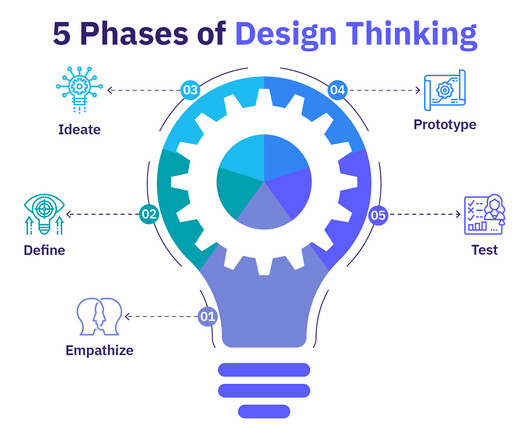
How To Apply Design Thinking in HR (+ 3 Case Studies)
AUGUST 16, 2023
The benefits of a design thinking approach in HR The 4 principles and 5 phases of design thinking 4 Ways to apply design thinking to HR processes Successful implementation of design thinking in HR Design thinking in HR examples What is design thinking? Recruitment and onboarding Consider how candidates experience the recruitment process.
Using Talent Sourcing Platforms To Save Recruiter Time
Select Software Reviews
MAY 17, 2019
Talent sourcing has become an incredibly important part of any recruiting strategy. In response, recruiters have been forced to rely more and more on outbound means to engage potential hires. Full desk recruiters don’t want to source. Source cfo.com. Sourcing is all these companies do.

Case Study: MarketGap’s Innovative Strategy for Agile Workforce Evolution
JUNE 30, 2023
Partnering with organizations and agencies that focus on promoting minority talents, such as minority professional associations and diversity-focused recruitment firms. The post Case Study : MarketGap’s Innovative Strategy for Agile Workforce Evolution appeared first on Hppy.

Top 100 HR and Recruitment Blogs [by Organic Traffic with Top 3 Articles Each]
APRIL 17, 2020
There are a ton of great HR/ Recruitment blogs. Ongig, of course, has its own recruiting blog — you’re reading it right now! This includes general HR blogs, recruiting blogs, talent acquisition blogs, employer branding blogs and more. Ok, here we go…these are the top 100 HR/ Recruitment blogs we found!

13 Best Recruitment Podcasts Recruiters Need To Listen To [Updated]
Recruit CRM
MAY 29, 2021
With recruitment networking events put to hold due to Covid-19, gather inspiration from these amazing podcasts that we've shortlisted. These 13 podcasts have been trending time and again providing recruiters with the latest tips, trends and best recruitment strategies this year. Did you tune in to it yet?

Case study: Executing a recruitment marketing video plan
MAY 19, 2021
Executing a recruitment marketing video plan sometimes requires research and buy-in. This case study is an excerpt from our new ebook, Getting Buy-In for Your Employee Story Project: The Ultimate Guide to Employer Branding and Recruitment Marketing ROI. Reading Time: 7 minutes. Brittni says, “I knew Stories Inc.

OKR Examples: How to Write OKRs that Drive Impact
OCTOBER 19, 2022
In this article, we’ll break down the framework for writing impactful objectives and key results and share some OKR examples you can use as a guide when crafting your own. Example of a poorly-written objective: Provide better customer service. Example of poorly-written key results: Treat our customers well every day.

Case Study: Credit Union
OCTOBER 1, 2020
Today’s case study explains how TimeSimplicity can help a typical small credit union maintain quality customer service while controlling operating expenses through automated credit union employee scheduling. Our example organization is Springfield Community Credit Union. How much can you save? ArticleID 7414.

Healthcare Hiring: Your Comprehensive Guide
ApplicantStack
OCTOBER 31, 2023
But when you’re responsible for recruiting in healthcare, you know just how many challenges can come with this role. Examples of physical locations that offer healthcare services include hospitals, medical and dental clinics, outpatient and inpatient care facilities, and assisted living facilities.

Case Study: The Value Of Pay Transparency And How To Implement It
HR Tech Girl
JULY 5, 2023
Here I aim to shed light on what pay transparency looks like at Compt, explain its mechanics and influence on overall compensation structures and raises, present real-world examples of its benefits, and provide practical considerations for organizations contemplating this approach.
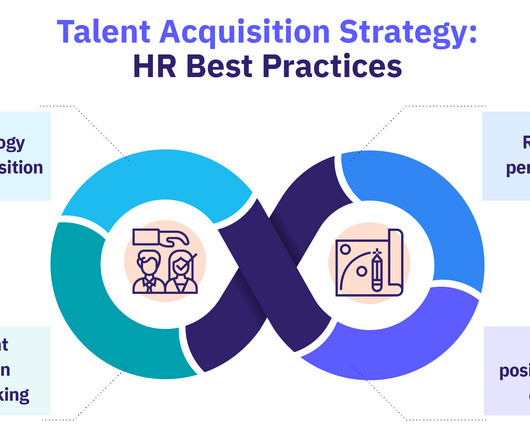
Develop Your Talent Acquisition Strategy With 6 Practical Examples
JULY 31, 2023
In this article, we’ll explore what a talent acquisition strategy looks like, how to develop a talent acquisition strategy, along with some best practices and examples to help you move your company forward. Software and applicant tracking systems can help you sort through your talent pool, assess candidates, and recruit .

Creating Employment Opportunities With Flex Manufacturing (i4cp login required)
MARCH 7, 2023
This case study represents one of the submissions for i4cp's 2023 Next Practice Awards, winners will be honored at the i4cp 2023 Next Practices Now Conference. You can also view other Next Practice Award case studies . A cross-functional team formed to include the Director of Manufacturing, his HRBP and Recruiting .

9 Digital HR Case Studies with Business Impact
Digital HR Tech
OCTOBER 23, 2019
In this article, we have collected some of the best Digital HR case studies we’ve come across. They’re good examples of organizations that really get Digital HR and make the most of it. Each case study is connected to a specific business imperative. What’s in? Anchor Trust 2. Deloitte 5.

Healthcare HR and Nursing Leaders: Partnering for Improved Outcomes
FEBRUARY 11, 2019
Creating a partnership between nursing leaders and HR, though, can help organizations do a better job recruiting and retaining nurses, leading to better workforce management for HR and improved care for patients. With a projected nursing shortage in the next decade , recruitment has never been more important for healthcare organizations.

Recruit Better: Employee Discount Programs and Taxes
HR Bartender
APRIL 16, 2017
Examples of de minimis perks include occasional tickets to theatres and sporting events, as well as invitations to company-hosted parties and picnics. That helps strengthen relationships and increase engagement with employees, and it can serve as a competitive differentiator and recruitment tool.
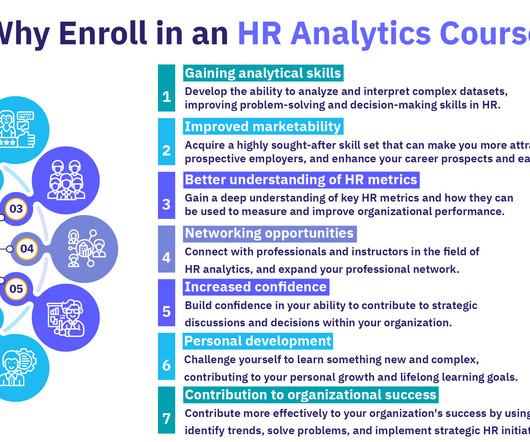
13 HR Analytics Courses Online To Check Out in 2024
All subjects are illustrated by real-life examples of how various organizations tap into HR analytics techniques to help them flourish. A dashboard example is included below. It includes facilitated discussions, case studies , group and individual activities, and self-assessments. Want to know more?
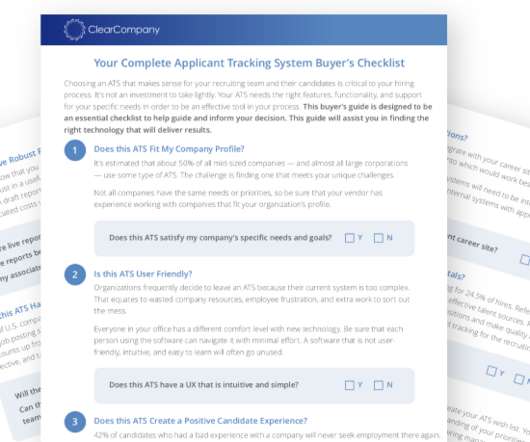
9 Rules for Choosing a Good Applicant Tracking System
ClearCompany HRM
DECEMBER 29, 2022
The purpose of an ATS is to expand your team’s capabilities, taking tedious recruiting and hiring tasks off their plates so they can focus on the parts of their jobs that can’t be automated. If your recruitment software isn’t eliminating obstacles and solving problems, there’s a better solution out there.

How to Identify Bottlenecks in Your Recruitment Process
DECEMBER 9, 2014
Take recruiting for example . When the recruiting process is broken, everybody knows it. And in my experience, everyone blames everything on recruiting being broken. “We Problems (or contraints) in recruiting isn’t something to ignore because finding top talent is essential to the business.

Navigating Uncertainty: The Strategic Imperative of Investing in People and HR Tech
FEBRUARY 7, 2024
Optimizing Operations HR tech serves as a catalyst for operational efficiency, streamlining processes such as recruitment , onboarding, and performance evaluation. This collection of case studies showcases success stories where savvy UAE companies harnessed the power of HR tech to drive out of the box results: 1.
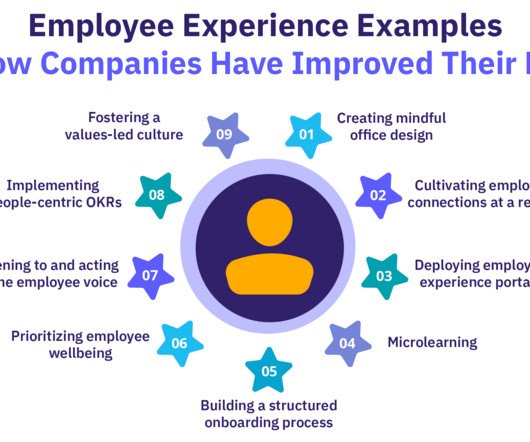
9 Inspiring Employee Experience Examples To Boost Your EX
JANUARY 12, 2024
These touch points are encounters with your policies, processes, and strategies from the first contact during recruitment to the offboarding and alumni policies. One of the best ways to learn is to look at specific employee experience examples , case studies , and initiatives deployed in other organizations. Contents 1.
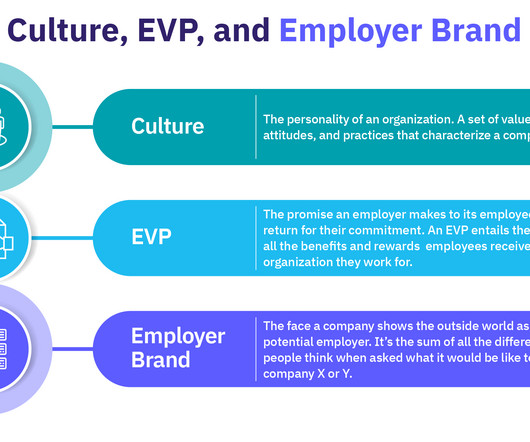
13 Great Employer Branding Examples To Inspire You in 2024
SEPTEMBER 15, 2023
In this article, we’ll share 13 exceptional employer branding examples and what we like about them to inspire you in building your employer branding strategy. Types of employer branding content Employer branding examples 1. Now, let’s dive into the best employer branding examples ! Contents What is employer branding?

If You’re Not Listening for These 4 Phrases When Hiring Teachers, You’re Missing Out
OCTOBER 8, 2018
Finding and hiring top teachers is one of the most important recruiting jobs. Today’s youth, for example , are dealing with complicated, multifaceted challenges due to various cultural and social aspects. According to a 2018 case study , the opportunity for learning is limited by these cultural and social differences.

People Analytics and HR-Tech Reading List
Littal Shemer
OCTOBER 11, 2022
“The book helps professionals, researchers, employers, and everybody interested in the world of work to understand the past, present, and future of recruitment . . “The book helps professionals, researchers, employers, and everybody interested in the world of work to understand the past, present, and future of recruitment .

How to master recruitment in media
DECEMBER 13, 2020
Case study : HubSpot. When you’re searching to recruit talent with media experience, you should place your ads in niche job boards, not only Indeed or Glassdoor. Recruiters who target journalists agree that it isn’t enough to review a writer’s work samples. Case study : HubSpot. HubSpot leads by example .

Why talent acquisition pros must learn to analyze data, according to a new book
HRExecutive
MARCH 25, 2024
The consulting firm also found that most HR departments use two or more platforms to facilitate the recruiting process. Throughout the chapters, practical examples and case studies from organizations across the globe provide real-world context. “We A study performed by St.

What is HR Automation? A Guide with Practical Examples
APRIL 8, 2021
HR is responsible for recruiting , onboarding and offboarding employees, training and development, payroll and timekeeping, tracking vacation and sick days, and employees’ general well-being within the organization. Benefits of HR automation Examples of HR automation in action The best HR automation tools currently on offer.
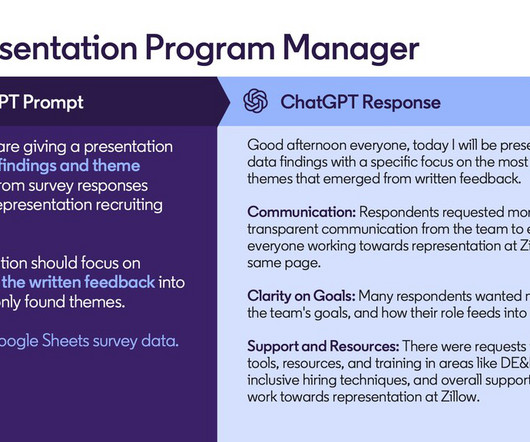
5 Ways to Revolutionize Recruiting with AI
Linkedin Talent Blog
DECEMBER 6, 2023
Namely, it gives recruiters more time for the human aspects of their work. “AI In one example , the team prompted the AI to “Act as if you’re giving a presentation on key data findings and theme takeaways from survey responses around our representation recruiting survey.” million job applications.
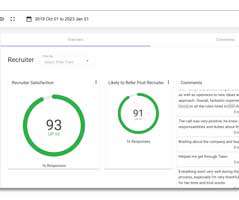
Trend: Candidate Feedback for Recruiter Reviews and Managing Recruiters
JANUARY 13, 2023
Using candidate feedback for recruiter reviews and managing recruiters is fast becoming standard practice these days. In fact MOST Survale clients use some form of candidate and/or hiring manager feedback in quarterly or annual recruiter reviews, incentive compensation or other systems for managing recruiters ’ performance.

Recruiting in the Era of International Accounting Standards: A Hiring Manager’s Handbook
FEBRUARY 9, 2024
Partnering with a Global Accounting Recruitment Agency Navigating the global accounting landscape and finding top talent can be a daunting task. One effective solution is to partner with a global accounting recruitment agency. Ready to elevate your expertise and drive success in global accounting?

A Real Life Example: The Benefits of Recruiting Chatbots
SelectSoftware
APRIL 28, 2020
If you’re looking to save time with your recruiting efforts, check out this case study .

Maximizing Talent Acquisition Success: The Qualigence and Valvoline Partnership
Qualigence Blog
MARCH 14, 2024
This blog explores the transformative partnership between Qualigence, a leader in recruitment and talent strategy, and Valvoline, a highly respected automotive services and products provider. Resource Augmentation : Leveraging additional full-cycle recruiting resources to enhance Valvoline’s recruitment capabilities.

Best Applicant Tracking Systems in 2022 | ClearCompany
APRIL 19, 2022
Think of a few things you would consider “the best,” for example , the best restaurants in your city or the best route to take to work. While ATS requirements differ, there are still many features and qualities that an ATS needs in order to remain a top competitor and help you reach your recruiting and hiring goals.

Guide to Hiring Employees in Luxembourg
Recruiters Lineup
APRIL 4, 2024
This could include technical tests, psychometric assessments, or case studies . It’s usually conducted by a recruiter or HR representative and serves to evaluate your basic qualifications and interest in the position. This could involve anything from coding exercises to case studies .
Stay Connected
Join 398,000+ Insiders by signing up for our newsletter
- Participate in Human Resources Today
- 2019 Human Resources Today Summer Reading List
- Stay At Home Reading List
- Add a Source
- Add a Resource
- See All
- 2018 Human Resources Today MVP Awards
- 2017 Human Resources Today MVP Awards
- 2019 Human Resources Today MVP Awards
- 2020 Human Resources Today MVP Awards
- 2021 Human Resources Today MVP Awards
- 2022 Human Resources Today MVP Awards
- Fri. May 03
- Thu. May 02
- Wed. May 01
- Tue. Apr 30
- Apr 20 - Apr 26
- Employee Engagement
- Onboarding Software
- Talent Management
- Performance Management
- Time and Attendance
- More Topics

Input your email to sign up, or if you already have an account, log in here!
Enter your email address to reset your password. a temporary password will be e‑mailed to you., be in the know on.
Human Resources Today
Expert insights. Personalized for you.
We organize all of the trending information in your field so you don't have to. Join 398,000+ users and stay up to date on the latest articles your peers are reading.

Get the good stuff
Subscribe to the following Human Resources Today newsletters:
You must accept the Privacy Policy and Terms & Conditions to proceed.

You know about us, now we want to get to know you!
Check your mail, we've sent an email to . please verify that you have received the email..
We have resent the email to
Let's personalize your content
Use social media to find articles.
We can use your profile and the content you share to understand your interests and provide content that is just for you.
Turn this off at any time. Your social media activity always remains private.
Let's get even more personalized
Choose topics that interest you., so, what do you do.
Are you sure you want to cancel your subscriptions?
Cancel my subscriptions
Don't cancel my subscriptions
Changing Country?
Accept terms & conditions.
It looks like you are changing your country/region of residence. In order to receive our emails, you must expressly agree. You can unsubscribe at any time by clicking the unsubscribe link at the bottom of our emails.
You appear to have previously removed your acceptance of the Terms & Conditions.

We noticed that you changed your country/region of residence; congratulations! In order to make this change, you must accept the Aggregage Terms and Conditions and Privacy Policy. Once you've accepted, then you will be able to choose which emails to receive from each site .
You must choose one option
Please choose which emails to receive from each site .
- Update All Sites
- Update Each Site
Please verify your previous choices for all sites
Sites have been updated - click Submit All Changes below to save your changes.
We recognize your account from another site in our network , please click 'Send Email' below to continue with verifying your account and setting a password.
You must accept the Privacy Policy and Terms & Conditions to proceed.
This is not me
- Privacy Policy
E-Recruitment System Case Study Analysis
E-recruitment system .
BAT telecom started its services from about one and a half year. It was the time of company when HR management of the company in its incubation period. There were about 1500 employees in the company—the plans to increase the strength of employees until 15000. At seven different metro offices, the company had an excellent method of rolling out a PAN network in India. At the starting, about 500 employees were hired for every quarter. The total number of divisions were about ten; data centres, wireline, wireless, national long distance, broadband, business support systems, decision support systems and support functions having several employees from 40 to 50 but support processes had a more considerable number of employees.
- What issues did the recruiters face before the implementation, and how did they tide over the old system?
The company wants to recruit new employees, but it had been found that loose company record of CVs from the candidates interviewed last week. It was the plan that one business group might interview the other business group can hire a candidate. The first issue that recruiters are facing is confusion and chaos because of a large number of groups. This is leading BAT telecom to create confusion with the HR management and facing trouble in managing a bulk of CVs from candidates. There was poor coordination between recruiters as the database was maintained in Microsoft Excel spreadsheet.
The second issue before the recruitment is a large number of CVs from 5000 candidates per month tricked by emails, hard copies or send by candidates interested in the jobs. It was hard for them to manage about 5000 CVs and to select 1000 to 1200 candidates for the positions. This large number of CVs from candidates was troublesome for recruiters, and they took pressure in this way.

As times passed, that bulk of CVs was got increased so much that the recruiters were finding it so hard to manage and keep track of all candidates. There is no doubt that it was a massive mistake by recruiters because they did it in a very wrong way. According to the case study, it was no less than a nightmare for the recruiters to file the CV of an interviewed candidate. It was a challenge for recruiters to deal with a CV for hours.
- What are the critical messages for recruiters?
It is a message for recruiters to implement a very different way of recruitment which could be hurdle free. There is no doubt that E-recruitment is only a way by which a considerable number of candidates can be recruited without thinking about the tensions of tracking their CVs. By this way, they could be able to maintain an exceptionally OK record of candidates which can be tracked easily. This type of recruitment may lead the company to have a good reputation because it could let the company to not waste time in following CVs. Each applicant could be appointed with a well-managed schedule. The administration of the company could work with consistency to increase the efficiency of the groups.
E-recruitment uses technology which is also beneficial for not having hard copies of CVs. E-recruitment could minimize the cost required for hiring candidates in recruitment. BAT telecom should be oriented to this way to make everything easy. It is also a very effective way of engaging people in a company. BAT telecom usually needed a long process for hiring candidates for their functional groups. Still, if they could implement E-recruitment, then they would able to save their time and money. Clear communication between candidates and recruiters could be possible without having many tensions in tracking CVs. The Internet made this world a global village on which anyone can access any data. Recruitment on the Internet includes versatile options, including ad posing for jobs, applying to companies, seeking response and communication about a job interview. These essential steps could be done with the help of the Internet that should be adopted by BAT telecom employers. It let employers of the company appoint their candidates for respective jobs rapidly. They can set a criterion by which a candidate can be assigned without the evaluation of human. The artificial intelligence technology can detect the right person; then, he should be interviewed for further process. Once it may be done, the system will be able to identify them according to the need of the job.
It is a green solution which doesn’t require any paper or pencil. It maintains the record in the soft form in a computer system. For this purpose, there is less physical space needed to keep a record. BAT telecom may have an integrated approach by which it can assess candidates with an end-to-end encrypted process. In the past, the recruitments were taken by papers, but now technology has made everything very convenient, which must have used by this telecom company. High-quality assessments in fair means could be possible even. The other responsibilities which were done for the vigilance of candidates may also be minimized. The eligible students could easily be filtered, and the company could only focus on them for their selections. By implementing this method, the company may not need to coordinate much with other departments because of clear and prominent eligibility of selective candidates. It plays a vital role in saving funds which a company raise for physical recruitments. In a recruitment process, the company pays for halls and other physical facilities as well as the employers who conduct recruitments must be paid with fees because they are referring a candidate for the company. If using technology, such type of costs could be saved. You may not need to pay a sign-on bonus or any extra fee for this process. Giving advertisements in newspapers also takes money which could be avoided by BAT telecom if using e-recruitment. The company could boost its recruitment on social media and other stations, which requires no or significantly less money which is almost negligible.
Instead of having a lot of CVs or resumes in hand to assess them for the best, it could be possible to let artificially intelligent computer systems to figure out which candidate is the perfect one. It is promising to find a candidate in this way because computers decide everything on fair means according to your requirements. There are various recruitment platforms on the Internet which could be used. These platforms analyze candidates according to their qualification and their assessment. These programs are also helpful in advertisements as they automatically send mails to respective candidate eligible for the recruitment.
Another main benefit that could be availed by BAT telecom was they can access to a wide range of audience. While recruiting in universities, colleges or technical institutes; company reached to a limited number of students every time spending time and money for each visit. By recruiting online, this company could be able to grasp a considerable number of candidates without occupying space, spending money or giving time. Anyone could be able to appear in recruitment because in the world of today, the Internet is for everyone, and we are in the age of technology.
By analyzing the flaws of physician recruitment, we can say that BAT telecom had a terrible choice of recruitment. They needed to go for E-recruitment to avoid a lot of disturbances company faced in selecting a candidate. These are some key messages for BAT telecom, and it will be sure that the company will consider e-recruitment very well next time.
Related Posts
A case study on sustainable building, suspicious behaviors of malware in android, how epa links with the superfund in new..., nokia case study analysis, importance of public spaces in a neighbourhood of..., community based tourism in uganda and tanzania, mount st. helens hazardous simulations, the contradiction of homosexuality, walmart cross-cultural issues case study analysis, case study on leadership and management, leave a comment cancel reply.
Please enter an answer in digits: two + nine =

IMAGES
VIDEO
COMMENTS
Lessons learnt. The three key learning points identified by Nike during the process of change management include: 1.The importance of involving recruiters in the development and implementation process from an early stage. 2. The benefit of ensuring that recruiters have a place in the project to help get buy-in.
Reengineering the Recruitment Process. The Covid-19 pandemic has upended many traditional business practices. When it comes to recruiting, the crisis has not so much disrupted as accelerated ...
E-recruitment systems can be seeker oriented or company ori- ented. In the first case the e-recruitment system recommends to the candidate a list of job positions that better fit his profile. In the second case recruiters publish the specifications of available job positions and the candidates can apply.
The present study fills part of this gap by investigating the effect of e-recruitment on the design of the recruitment process. Three explorative case studies were carried out in three large organisations in Denmark in 2008-2010. The findings indicate that e-recruitment transforms the traditional recruitment process into a time- and space ...
of e-recruitment has an impact on the process and underlying tasks, subtasks and activities of recruitment. Three large organizations with well-established e-recruitment practices were included in the study. The case studies were conducted in Denmark in 2008-2009 using qualitative research methods.
the effect of e-recruitment on the design of the recruitment process. Three explorative case studies were carried out in three large organisations in Denmark in 2008-2010. The findings indicate that e-recruitment transforms the traditional recruitment process into a time- and space-independent, collaborative hiring process. The most significant
These case studies were conducted and written by Annette Hogarth, research consultant. The CIPD and Omni would like to thank all the case study organisations for taking part in this research. We appreciate that taking time out among other pressing commitments to be ... recruitment process with all new hires to learn lessons, including what the
Three large organizations with well- established e-recruitment practices were included in the study. The case studies were conducted in Denmark in 2008-2009 using qualitative research methods. The findings indicate that e-recruitment had a noticeable effect on the overall recruitment process in the studied organizations.
E-recruitment systems can be seeker oriented or company ori-ented. In the first case the e-recruitment system recommends to the candidate a list of job positions that better fit his profile. In the second case recruiters publish the specifications of available job positions and the candidates can apply. Applicant's upload their CVs in the form
The Effectiveness of E-Recruitment Method Through Social Media (Case Study at Pt Es Teh Tndonesia Makmur - West Java) Jazimatul Husna1, Salsabila Sadiqin2, Yahya Muhaimin3, Fitriyana4, Roisatul Wahdiyah5 1Lecturers of Information and Public Relations, Vocational School, Diponegoro University, Indonesia 2Students of Information and Public Relations, Vocational School, Diponegoro University ...
Internet-led labour market has become so competitive it is forcing many organisations from different sectors to embrace e-recruitment. However, realising the value of the e-recruitment from a Requirements Engineering (RE) analysis perspective is challenging. This research was motivated by the results of a failed e-recruitment project conducted in military domain which was used as a case study ...
E-recruitment is viewed in some studies as a technology tool : 2. E-recruitment as a System: E-recruitment is a group of independent but interrelated elements comprising a unified whole. These elements include technology, society, organizations, etc. [23-29] 3. E-recruitment as a Process: E-recruitment is a set of systematic well-coordinated ...
IES case study members shared our conclusion that better information about the end-to-end process should lead to better decisions about any investment in e-recruitment. An evaluation approach linked to the staffing process, as 'value chain' we argue, is the way forward if organisations are going to truly understand the value of e-recruitment.
E- Recruitment is the latest trend and it has been adopted by large and small-sized organizations. The core objective of this study is to analyse the overall trends in e- Recruitment use and practice and to list the opportunities and challenges faced by job seekers and employers. 2.
explorative study of recruitment practices conducted in Denmark in 2008-2009. Fi-nally, it draws a number of general and specific conclusions and suggests some impli-cations and areas for future research in the field of e-recruitment and e-HRM. 2 Theoretical Background . 2.1 e-Recruitment and e-HRM
Dr. Ankita Jain and Ankita Goyal (2014), E-Recruitment & E-Human Resource Management Challenges in the Flat World: A Case Study of Indian Banking Industry (With Special Reference to ICICI Bank ...
Khuri (2016), addressed a study on impact of e-recruitment on the attitude of the job seekers' perception and their intention to pursue the job. He shows this study internet is the most preferred source to search job. ... process brought trend in present recruitment process. The case study helps to analyze the usage and practice
3.1 E-recruitment as a Technology Tool. E-recruitment as a technology tool is a conceptualization of e-recruitment as a technical artefact [].This means is demonstrated by Faliagka et al. [] who presented a tool to automate the ranking of applicants in recruitment.3.2 E-recruitment as a System. Studies that view e-recruitment as a system conceptually divide e-recruitment into independent but ...
The research presented in this paper attempts to answer the fundamental question whether e-recruitment should be understood as means of automating the process of recruitment, or rather be treated as a more complex organisational concept. Although electronic recruitment is a widespread managerial practice of acquiring personnel, it still remains unclear exactly which organisational processes ...
Case study: Executing a recruitment marketing video plan. Stories Incorporated HR. MAY 19, 2021. Executing a recruitment marketing video plan sometimes requires research and buy-in. This case study is an excerpt from our new ebook, Getting Buy-In for Your Employee Story Project: The Ultimate Guide to Employer Branding and Recruitment Marketing ...
E-recruitment helps reach a wide variety of employers as well as prospective candidates spanning geographical boundaries and is so much quicker, easier, cheaper and efficient than traditional means. E-recruitment facilitates 24 x 7 accesses and pick over out the unqualified candidates in an automated way.
This study aims to: (1) Know the media for posting jobs and the application of the recruitment process through social media, including the stages and qualifications and competencies required at PT Es Teh Indonesia Makmur (2) Knowing the effectiveness of recruitment methods through social media to reduce the impact of the Covid-19 pandemic era ...
E-Recruitment System. BAT telecom started its services from about one and a half year. It was the time of company when HR management of the company in its incubation period. There were about 1500 employees in the company—the plans to increase the strength of employees until 15000. At seven different metro offices, the company had an excellent ...